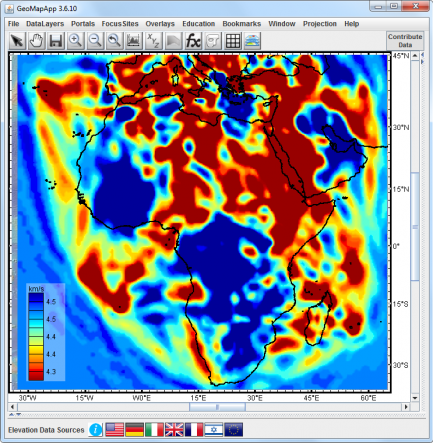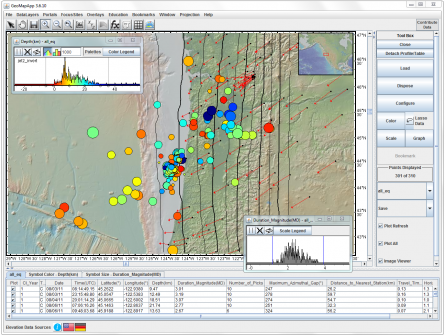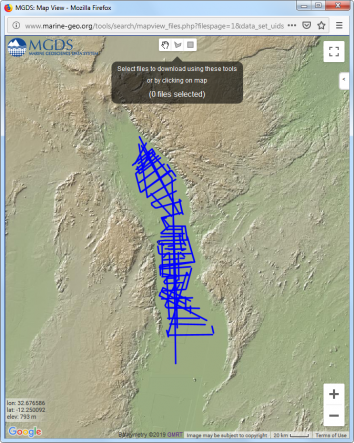The GeoPRISMS data portal was established in 2011 to provide convenient access to data and information for each primary site as well as to other relevant data resources. Since the last newsletter report, highlighted below are recent contributions of data sets and field program information of interest to the GeoPRISMS community. Many of the data sets described are also available in GeoMapApp under the Focus Site and DataLayers menus.
East African Rift System
Grids of upper mantle isotropic seismic velocity structure beneath Africa were contributed by Erica Emry. Derived using new full-wave seismic tomography techniques on ambient noise and earthquake data the grids shed light on relationships between mantle flow, cratonic lithosphere and surface processes. The data set has been added to GeoMapApp (Fig. 1).
As part of an integrated study of tectonic and magmatic processes during the onset of rifting, also now available in the data portal is the active-source seismic shot data from the 2015 SEGMeNT survey on Lake Malawi (Fig. 2). Led by Shillington et al. the survey focused upon the northern Malawi (Nyasa) rift, a region of early-stage rifting in strong, cold lithosphere, and imaged sedimentary and crustal structure within and around the lake. The data set is available here.
Cascadia
Derived from Cascadia Initiative OBS data, Emily Morton and Sue Bilek contributed a new microseismicity catalogue of earthquakes detected and located offshore central Oregon for the period 2011-2015. The catalog (Fig. 3) was generated using a subspace detection technique and includes hypocentral locations and duration magnitudes. The data set is available here.
New Zealand
To better understand the forces that drive early-stage subduction, investigators Mike Gurnis, Sean Gulick, Joann Stock, Harm Van Avendonk and Rupert Sutherland conducted a 2-D active-source survey of the Puysegur segment of the Macquarie Ridge Complex (Fig. 4). The 2018 Langseth cruise, dubbed “SISIE”, collected multi-channel seismic reflection data sets which may be viewed here. This Puysegur-Fiordland boundary south of New Zealand’s South Island represents a type-example of incipient subduction.


GeoPRISMS Data Portal Tools and Other Relevant IEDA Resources
Search For Data – The GeoPRISMS search tool provides a quick way to find GeoPRISMS data using parameters such as keyword, NSF award number, publications, and geographical extent.
Data Management Plan tool – Generate a data management plan for your NSF proposal. The online form can be quickly filled in, printed in PDF format, and attached to a proposal. PIs can use an old plan as a template to create a new plan. We also have developed a tool to help PIs show compliance with NSF data policies.
GeoPRISMS Bibliography – With more than 90 GeoPRISMS-funded citations, many tied to data sets, the references database can be searched by primary site, paper title, author, year, and journal. Submit your papers for inclusion in the bibliography – just the DOI is needed!
Contribute Data – The web submission tools support PI contributions of geophysical, geochemical, and sample data. Once registered within the IEDA systems, the data sets become available to the broader community immediately or may be placed on restricted hold. Additionally, PIs can choose to have a DOI assigned to each submitted data set, allowing it to become part of the formal, citable scientific record.
The GeoPRISMS Data Portal team is here to serve the community. Please contact us at info (at) geoprisms.nineplanetsllc.com


